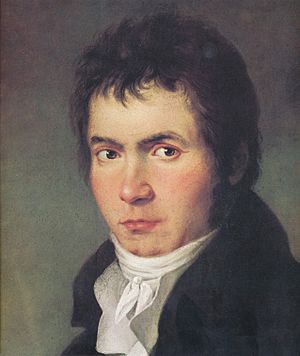Symphony No. 4 (Beethoven) facts for kids
The Symphony No. 4 in B-flat major, Op. 60, is a famous piece of music by Ludwig van Beethoven. He finished writing it in 1806. It was first played for a private audience in March 1807 in Vienna, at the home of Prince Lobkowitz. The public first heard it in April 1808 at the Burgtheater in Vienna.
This symphony has four parts, called movements. It sounds mostly happy and cheerful. Sometimes, people don't notice it as much because it comes between two of Beethoven's very famous and powerful symphonies: the Third Symphony (Eroica)(the "Heroic" Symphony) and the Fifth Symphony. Even though other great composers like Berlioz and Schumann loved this symphony, it's not as well-known as some of Beethoven's other works.
Contents
How the Symphony Was Created
Beethoven's Summer and a New Idea
In the summer of 1806, Beethoven stayed at the country home of his friend, Prince Lichnowsky. This home was near a place called Glogau. In September, Beethoven and the Prince visited another friend, Count Franz von Oppersdorff. The Count had his own orchestra!
To honor Beethoven, the Count's orchestra played Beethoven's Second Symphony. The Count liked it so much that he offered Beethoven a lot of money to write a brand new symphony just for him.
Why the Fourth Symphony?
At this time, Beethoven was already working on what would become his very famous Fifth Symphony. So, why did he write the Fourth Symphony instead? There are a few ideas about this:
- Some people think Beethoven needed money, so he decided to offer his Fifth Symphony (and his Sixth Symphony, the "Pastoral") to other wealthy patrons, Prince Lobkowitz and Count Razumovsky.
- Another idea is that the Fourth Symphony was almost finished before the Count asked for a new piece.
- Perhaps Beethoven wasn't quite ready to finish the "radical and emotional" Fifth Symphony yet.
- Also, the Count really liked the Second Symphony, which was more like the music of Joseph Haydn. This might have made Beethoven want to write another symphony in a similar, lighter style.
First Performances and Publication
Beethoven dedicated the Fourth Symphony to Count Franz von Oppersdorff. Even though the Count paid for the symphony and had exclusive rights to it for six months, his orchestra didn't play it first.
The very first performance was a private concert in March 1807 at Prince Lobkowitz's house in Vienna. The first time the public could hear it was in April 1808 at the Burgtheater in Vienna. The sheet music for the orchestra parts was printed in March 1809. However, the full score (all the parts together) wasn't printed until 1821. The original handwritten music was once owned by Felix Mendelssohn and is now kept in the Berlin State Library. You can even see it online!
Recordings of the Symphony
Listening to the Fourth Symphony Today
The Fourth Symphony has been recorded many, many times. There are over a hundred different recordings! You can find it in studios or from live concerts.
- Older Recordings: Early recordings were often sold as single albums or sometimes with another Beethoven symphony. Famous conductors like Felix Weingartner (1933) and Arturo Toscanini (1939) made recordings when music was still recorded in "mono" (meaning sound came from one direction).
- Stereo Recordings: In the mid-1950s, "stereo" recordings became popular, where sound came from different directions, making it sound more like a live performance. Conductors like Otto Klemperer (1957) and Herbert von Karajan (1963) made recordings during this time.
- "Authentic" Style: Starting in the late 1950s, some musicians began trying to play Beethoven's music exactly as it might have sounded in his time. They used old instruments or copies of them and tried to follow Beethoven's original speed markings, which were often very fast. Conductors like Christopher Hogwood (1986) and John Eliot Gardiner (1994) are known for these "authentic" style recordings.
- Modern Recordings: Today, many conductors use modern orchestras but still learn from the "authentic" style. For example, Nikolaus Harnoncourt (1992) and Sir Charles Mackerras (2007) have made popular recordings. In 2015, a survey recommended the recording by the Zurich Tonhalle Orchestra, conducted by David Zinman. Other well-known conductors like Leonard Bernstein (1980) and Claudio Abbado (2000) have also made great recordings in a more traditional style.
See also
- In Spanish: Sinfonía n.º 4 (Beethoven) para niños


